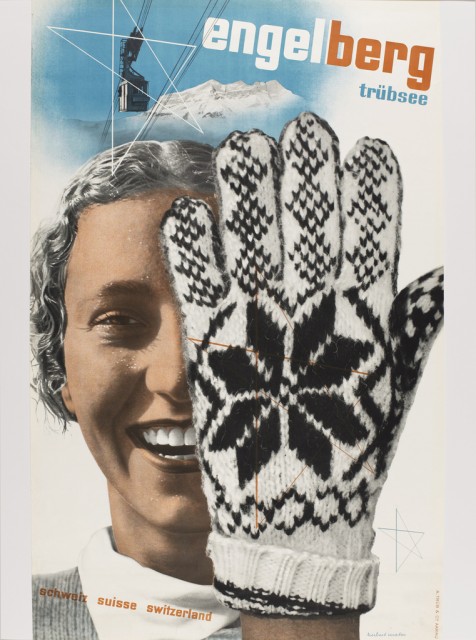How can you not love that glove? It takes up nearly half the image, so bold yet enigmatic. The gloved hand and the face of the exuberant young woman are likely separate images, brought together—brought into meaning with each other—purely by their adjacency. The photomontage does not quite read as a coherent image, but as a set of concentric ideas, an image more potent than a single photograph of both objects could capture. Without explicitly showing any particular activity, the poster evokes modern technology, natural beauty and winter fun, linking them all to an idea of Switzerland.
This is an early work by the Swiss modernist designer Herbert Matter, done when he was in his late 20s. After a brief stint working as a designer in Paris, Matter was commissioned by the Swiss Tourist Office to design a series of travel posters, from which this poster comes. All the posters in the series use photomontages of black-and-white images colorized with limited palettes.
Englelberg, in central Switzerland, was Matter’s home town. The word “Engelberg” in a blocky sans-serif typeface, bisected by color, recalls the red and white of the Swiss flag. Beneath this is “Trubsee” a mountain lake not far from the town, and the base of a cable car run coming down from Gerschnialp mountain. The cable car, constructed about ten years earlier, was a great tourist attraction—its gondola lift appears on other Matter travel posters—and the converging lines of its cables draw the eye down from the word “Engelberg” to the young woman’s beaming face.
We’re told of the cold waters of the Trubsee and the vertiginous panoramas from the cable car without being shown them. Instead, Matter gives us the young woman’s joyous face, lightly freckled with snow, and that great gloved hand, with all the happy associations of good, wooly yarn on a cold day. The design gives the knit pattern the center stage. It’s a style that was very popular in the 1930s, derived from the traditional black and white mittens knit in Selbu, Norway—the central motif of the eight-pointed snowflake shape is known as a Selbu rose.
At once familiar and mysterious, the back of the gloved hand covers part of the woman’s face, as if she’s playing a grown-up game of peek-a-boo with us. The composition recalls avant-garde photomontages, especially Herbert Bayer’s Lonely Metropolitan (1932), a surrealist image of two large hands, with eyes superimposed, floating against an urban apartment block. Yet nothing of Bayer’s disquieting, hallucinatory claustrophobia appears in Matter’s travel poster. Whether because of its folksy knit pattern, its casual cuff at the bottom or its pure insouciance, the glove seems only to hint at a promise of winter fun. Matter has digested the visual experiments of the avant-garde and domesticated them.
